Ergodic capacity analysis for device-to-device communication underlaying cellular networks
Li XujieZhang HonglangZhang WennaLiWenfeng
(1College of Computer and Information Engineering,Hohai University,Nanjing 210098,China)
(2Shanghai Key Laboratory of Intelligent Information Processing,Fudan University,Shanghai200433,China)
(3Hubei Key Laboratory of IntelligentW ireless Communications,South-Central University for Nationalities,Wuhan 430074,China)
(4School of Electronic Science and Engineering,Nanjing University,Nanjing 210023,China)
Ergodic capacity analysis for device-to-device communication underlaying cellular networks
Li Xujie1,2,3Zhang Honglang1Zhang Wenna1LiWenfeng4
(1College of Computer and Information Engineering,Hohai University,Nanjing 210098,China)
(2Shanghai Key Laboratory of Intelligent Information Processing,Fudan University,Shanghai200433,China)
(3Hubei Key Laboratory of IntelligentW ireless Communications,South-Central University for Nationalities,Wuhan 430074,China)
(4School of Electronic Science and Engineering,Nanjing University,Nanjing 210023,China)
The ergodic capacity of device-to-device(D2D)communication underlaying cellular networks is analyzed.First,the D2D communication model is introduced and the interference during uplink period and downlink period is analyzed.In a D2D communication system,since it is very difficult to obtain the instantaneous channel state information(CSI),assume that only the transmitters know the statistical CSI and the channel coefficient follows an independent complex Gaussian distribution.Based on the assumptions,for the uplink period,the signal to interference plus noise ratio(SINR)of the D2D user equipments(DUEs)is expressed.Then the cumulative distribution function(CDF)and probability distribution function(PDF)formulae of the SINR of the DUEs are presented.Based on the SINR formulae during the uplink period,the ergodic capacity formula of the uplink period is derived.Subsequently,using the same methods,the ergodic capacity formula of the downlink period is derived.The simulation results show that the DUEs can still obtain a high ergodic capacity even in the case of a large number of DUEs.This result can be applied to the design and optimization of D2D communications.
device-to-device(D2D);ergodic capacity;cellular networks
In recent years,w ireless data traffic has dramatically increased w ith the emergence of various new mobile applications.The w ireless spectrum resource is becom ing increasingly scarcew ith the rapid development of w ireless communications services.Device-to-device(D2D)communications can effectively improve resource utilization in cellular networks for the licensed and unlicensed spectrum[1].
Capacity enhancement is an important research field for D2D communications.Currently,most related papers focus on resource management and interference suppression to improve capacity.In Ref.[2],optimum resource allocation and power control between the cellular and D2D connections that share the same resources are analyzed for different resource sharingmodes.However,they only consider the case that one cellular user and two D2D users share the same radio resources.In Ref.[3],a new interferencemanagement scheme is proposed to improve the reliability of D2D communications in the uplink period without reducing the signal to interference plus noise ratio(SINR)of CUEs.However,the scheme is not effective for the strong and small interference regimes.In Ref.[4],the D2D reuses resources of cellular users near the base station(BS),which bring greater improvements in the outage probability of cellular users.However,this scheme is seriously lim ited by the region.In Ref.[5],an optimal D2D allocation overmulti-bands in the heterogeneous networks is analyzed.By allocating D2D users on different bands,it can reduce the interference between D2D and cellular networks and improve D2D transm ission capacity.In Ref.[6],a new interference management strategy is proposed to enhance the overall capacity of cellular networks and D2D systems.However,they only focus on the case that one D2D pair and multiple CUEs share the same resources and do not consider the case that multiple D2D pairs and multiple CUEs share the same resources.In Ref.[7],a distributed dynamic spectrum protocol in which ad hoc D2D users opportunistically access the spectrum used by cellular users is developed.This paper shows that two D2D users can communicate w ith a low outage probability while only minimally affecting the cellular network.
Overall,the related papers rarely focus on the ergodic capacity analysis of D2D communications.In this paper,we analyze the ergodic capacity of D2D communications underlaying cellular networks.It is assumed that DUEs and CUEs follow a uniform distribution in the network.To obtain the ergodic capacity of the DUEs,the SINR formula of the DUEs is expressed.Then,based on the SINR formula,the ergodic capacity formula is derived.This result can be applied to the design and optim ization of D2D communications.
1 System M odel
Let us consider a single cell environment where MDUE pairs and N CUEs coexist,as illustrated in Fig.1.These UEs share the same radio resources.Hence,there ismutual interference between CUEs and DUEs.Overall,there are four types of interference as follows:DUEs to CUEs,DUEs to DUEs,CUEs to CUEs,and CUEs to DUEs.Therefore,the additional interference has an impact on the ergodic capacity.Meanwhile,a smartantenna is deployed at the BS and an omnidirectional antenna is adopted at the UEs.The D2D interference to cellular networks can be effectively managed using the power control scheme which strictly lim its the maximum transmitting power of the D2D transmitter[8].During the downlink period,one DUE only receives the interference from other DUEs because N multiple antennas facing towards their CUEs are deployed at the BS.However,during the uplink period,the received interference at the DUE consists of two parts.One part is from CUEs,and the other part is from other DUEs.
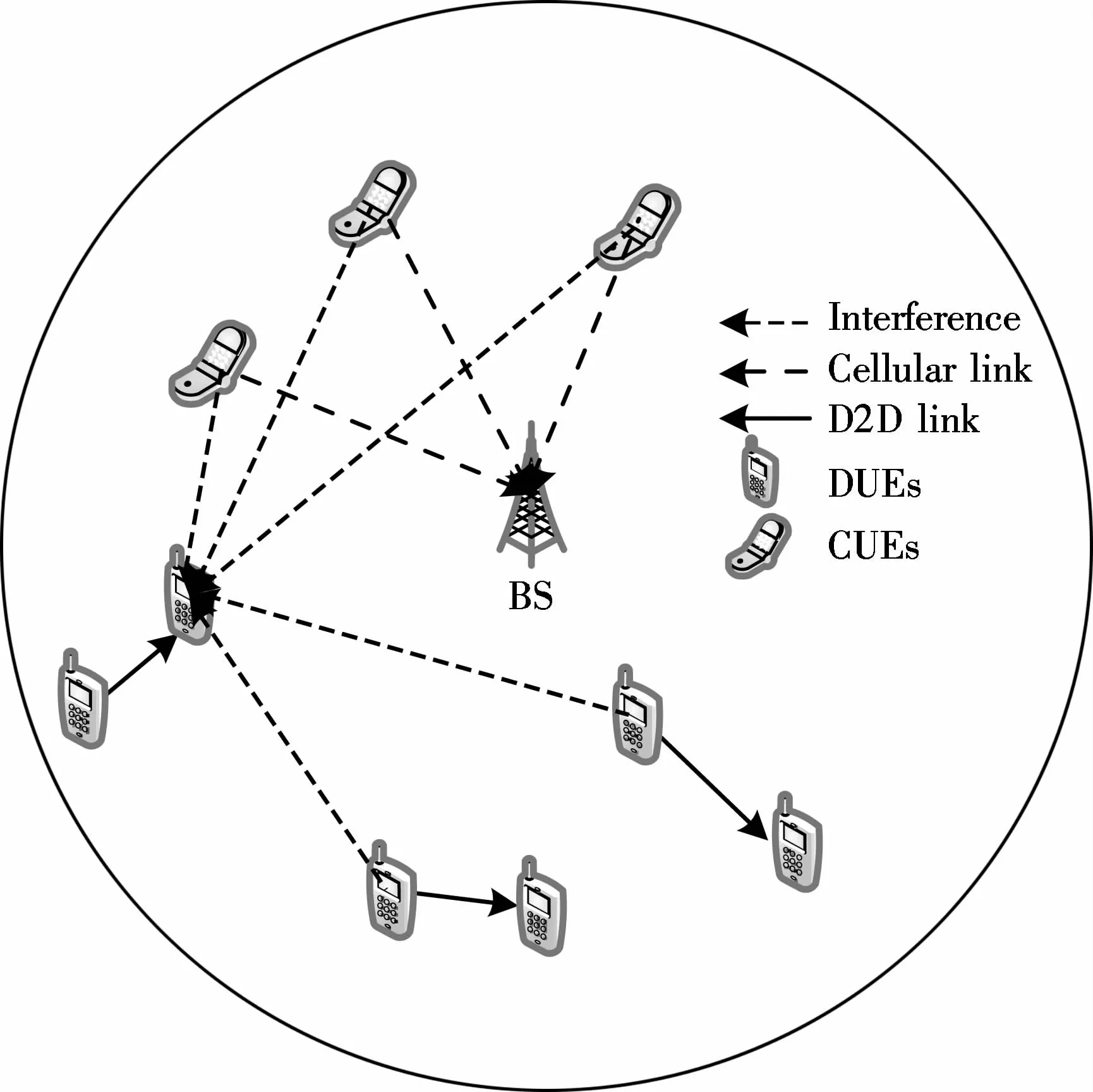
Fig.1 System model of D2D communication underlaying cellular networks
In D2D communications,the communication parties are close together in general,and they can transm it information directly.By this token,the D2D communication link between the transm itter and receiver of a pair of DUEs is sim ilar to that of an ad hoc network w ith short distance.Therefore,we assume that the DUE links follow amedian path lossmodel having the form PR/PT=1/rα[9].Where PRis the received power at the DUE;PTis the transm itting power of the DUE;r is the distance between the transm itter and receiver of a pair of DUEs;α is the path loss exponent.Meanwhile,we consider that the cellular links and the D2D links between different DUE pairs follow the Rayleigh fading channelmodel[10].Based on the above assumption,the ergodic capacity of D2D communications is analyzed and the corresponding formulae are derived in the next section.
2 Ergodic Capacity Analysis
In D2D communications,two DUEs can directly communicate if they are close in distance.Clearly,D2D communications can effectively improve network capacity.However,at the same time,the additional interference between the CUEs and DUEs is introduced due to using the same frequency band.The additional interference w ill decrease the network capacity.The ergodic capacity corresponds to the maximum long-term achievable rate averaged over all states of the time-varying channel[11].Next,we analyze the uplink ergodic capacity and downlink ergodic capacity,respectively.
2.1 Uplink ergodic capacity
In this paper,we consider that the transm itting powers for all DUEs are the same and denoted as PT.Then the received SINR at DUE k can be w ritten as

In Eq.(1),the noise power is negligible[12].Therefore,the received SINR at DUE k is approximately expressed as




To make the notation uniform,letμu={1/λ1,…,1/λM,1/λ′1,…,1/λ′N}.
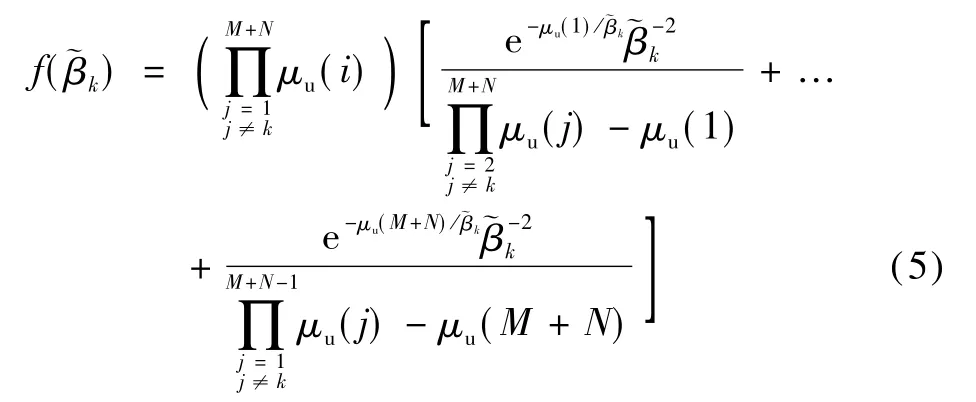

Therefore,the variable x is the sum ofmultiple exponential random variables w ith different parameters[13].
Then we can obtain the PDF of x,
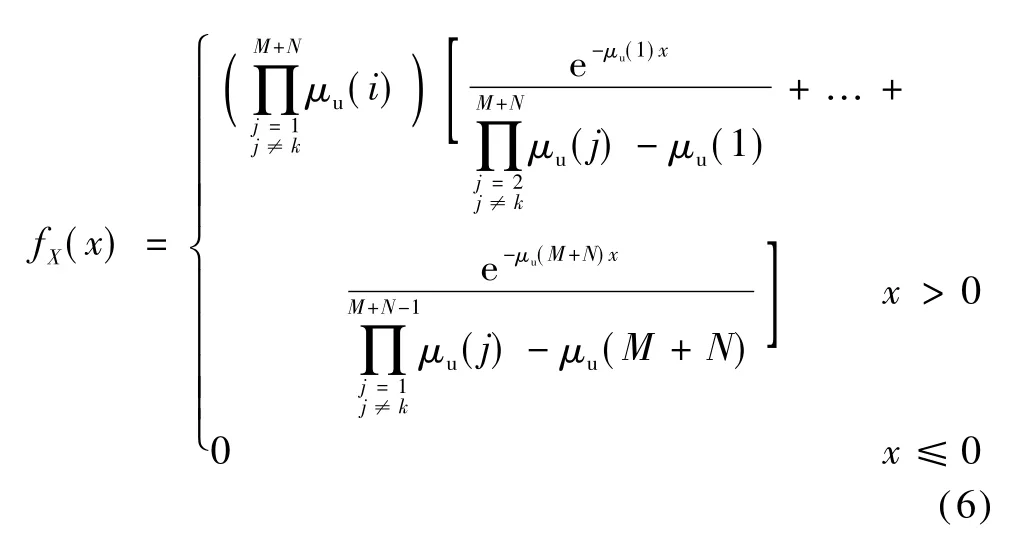
Next,let y=1/x,and the cumulative distribution function(CDF)of y is obtained as
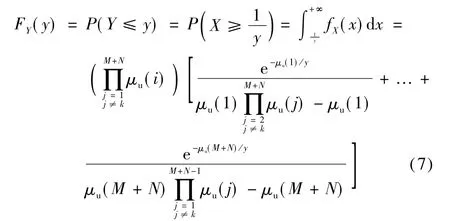
Finally,the PDF of y can be obtained from the CDF by differentiation:
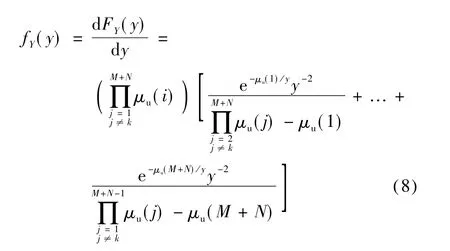
Corollary 1 The uplink ergodic capacity of DUE k can be w ritten as
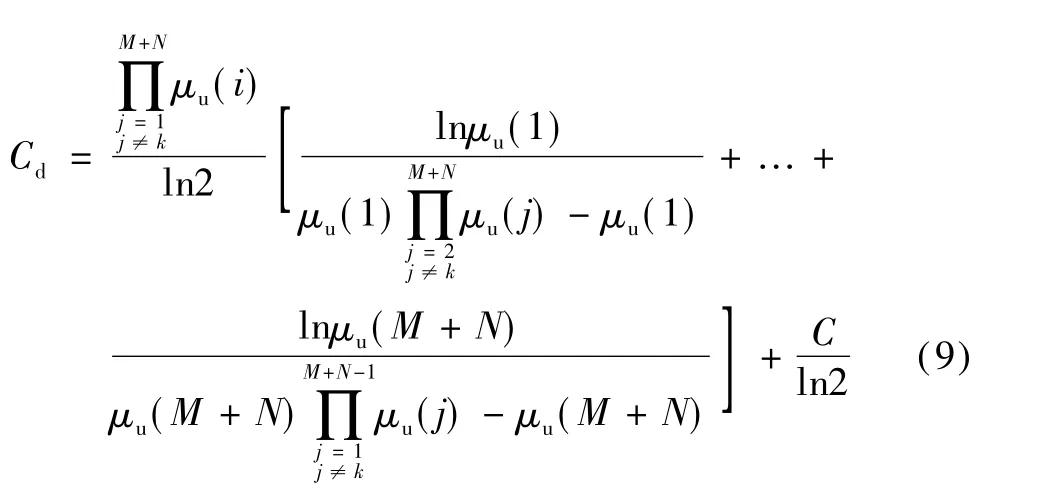
Proof The uplink ergodic capacity is expressed as[14]

Finally,substituting Eq.(8)into Eq.(10),we obtain
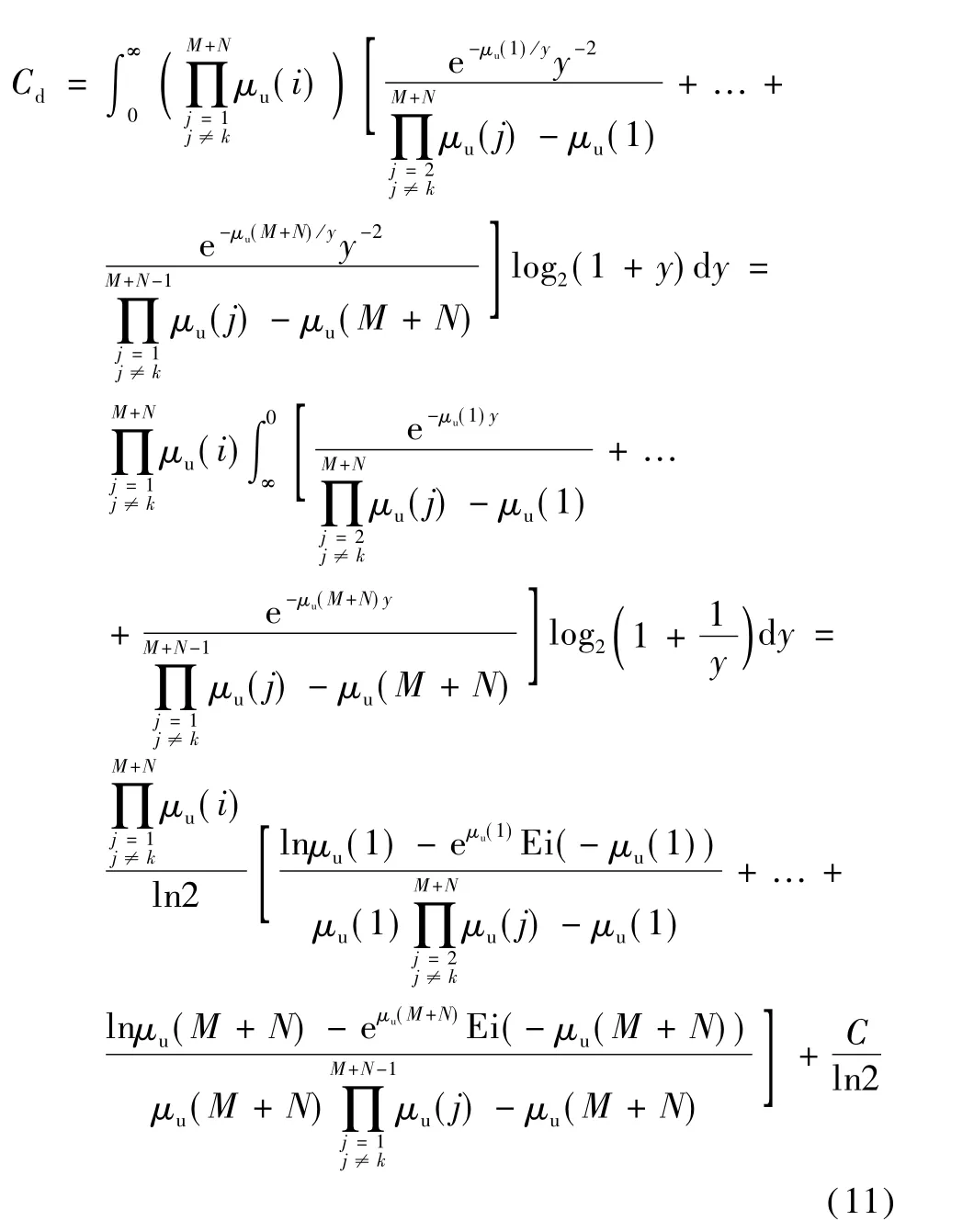
It is easy to verify eμu(M+N)Ei(-μu(M+N))≈0.Therefore,Eq.(11)is simplified to
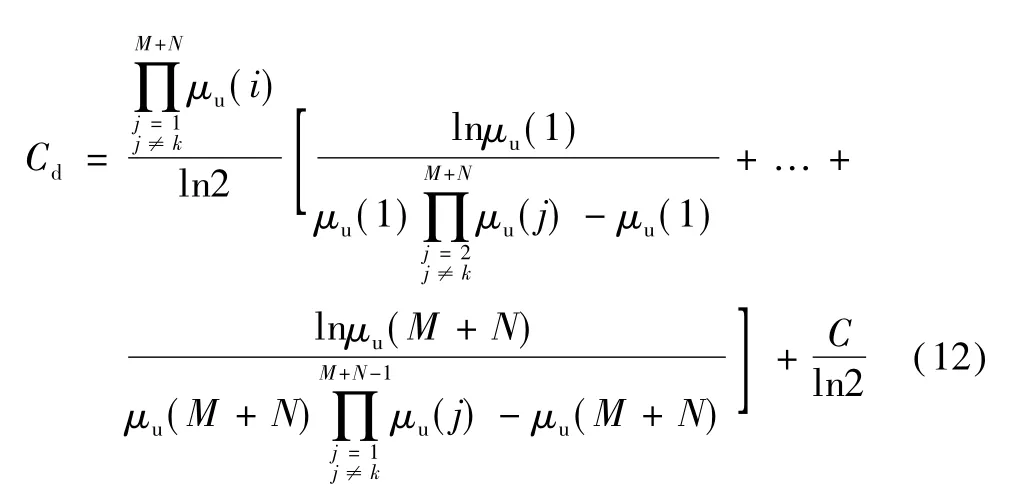
2.2 Downlink ergodic capacity
During the downlink period,one DUE only receives the interference from other DUEs.Then the received SINR at DUE k in the downlink period is given by
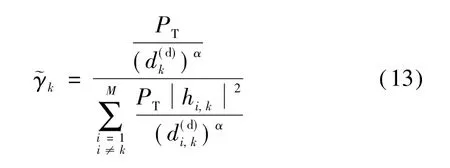
Similarly,we letμd={1/λ1,1/λ2,…,1/λM}.Then the PDF ofcan be obtained as
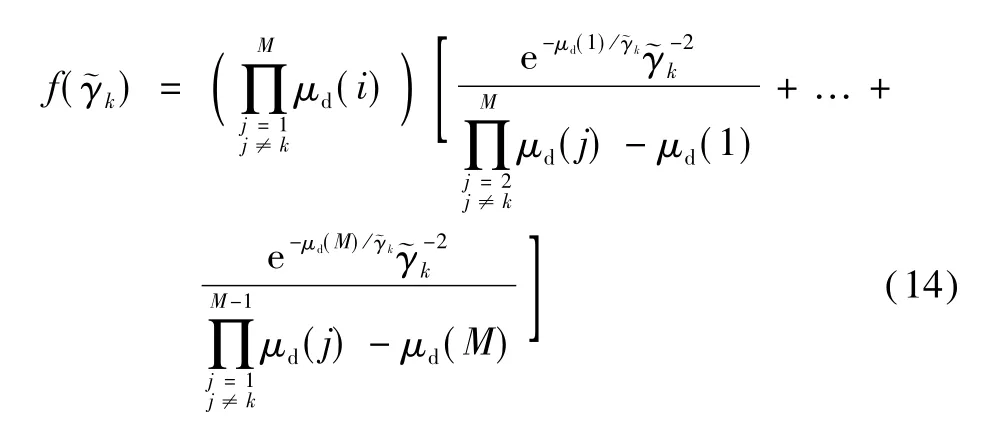
Finally,the downlink ergodic capacity of DUE k is w ritten as
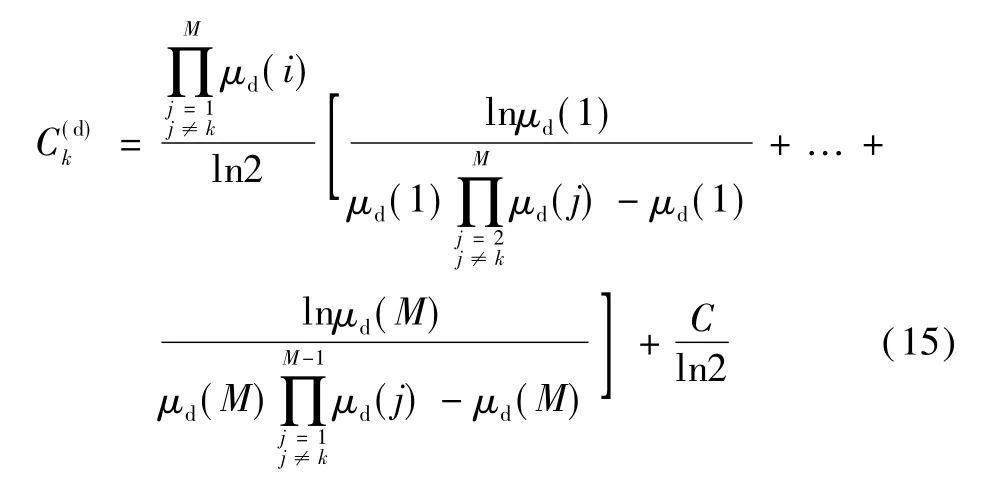
In conclusion,we can obtain the ergodic capacity of DUE k,

where Tdand Tuare the downlink duration and uplink duration of DUE k,respectively.
3 Numerical Results and Discussion
3.1 Simulation setup and parameter setting
In our simulations,we consider that DUEs random ly locate in the cellw ith a radius of R and the transmitter of a DUE pair locates in the circle w ith a center at the receiver of the DUE pair and radius equal to L.Due to the randomness of the positions of UEs,it is very difficult to obtain the exact value of the ergodic capacity in the real D2D communications.The Monte Carlo simulation is adopted in this paper.Simulation parameters are summarized in Tab.1.

Tab.1 Simulation parameters
3.2 Numerical results
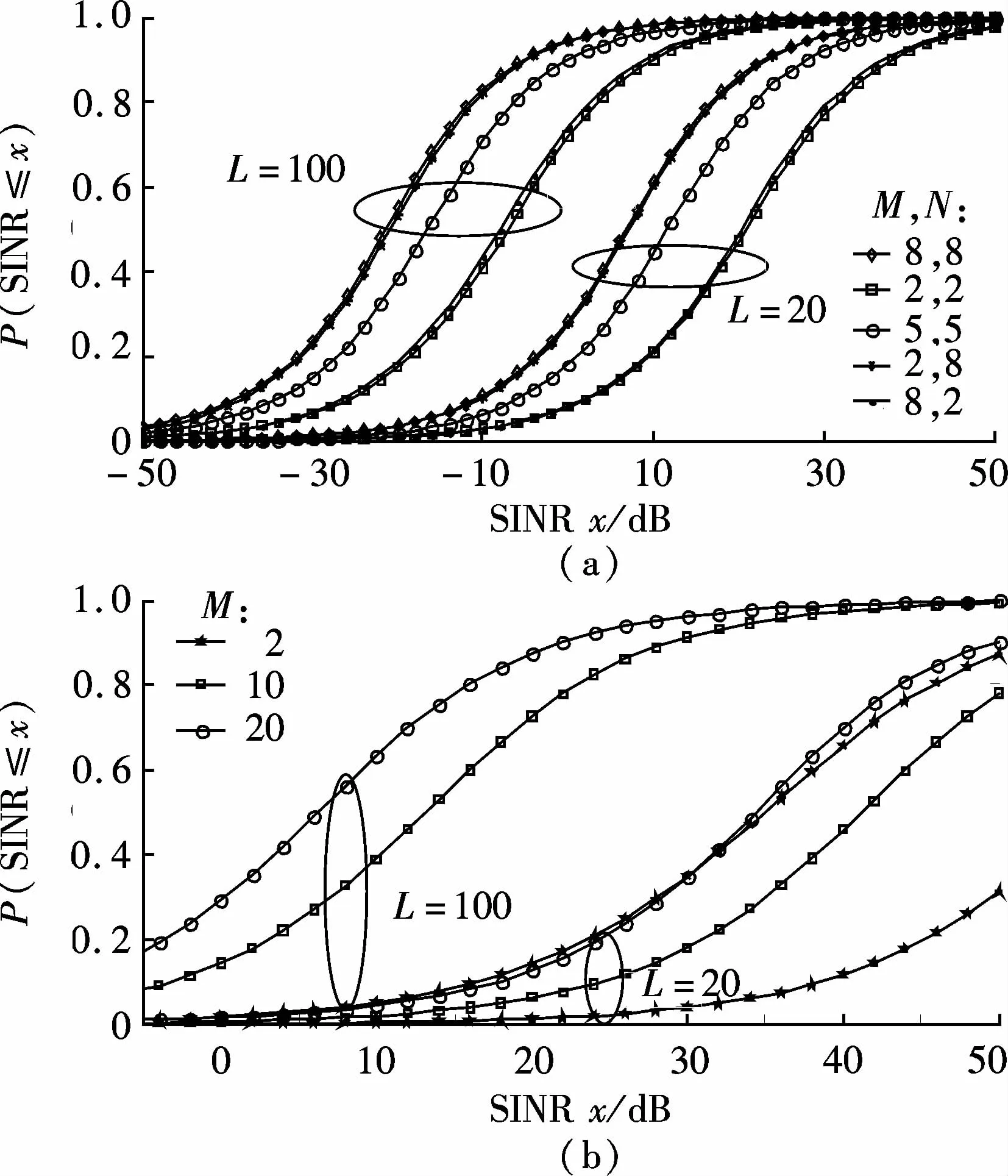
Fig.2 CDF of the SINR of the DUEs.(a)Uplink;(b)Downlink
Fig.2 shows the CDF of the SINR of the DUEsw ith L=20,100.Fig.2(a)shows the CDF during the uplink period.Obviously,the SINR of the DUEs becomes smaller w ith the increase of L.The reason is that the longer the distance between the transm itter and receiver of a DUE pair,the smaller the received signal at the receiver.Meanwhile,given the L,we can see that the SINR becomes smaller w ith the increase of the numbers of CUEs and DUE pairs in the network.Under the condition of a certain N,the increase of M slightly leads to the decline of the SINR.In other words,the DUE pairs introduce less interference into the network due to their low trans-m itting powers compared w ith the CUEs.Therefore,we can see that the number of CUEs plays a dom inant role.Fig.2(b)shows the CDF of the SINR during the downlink period.Likew ise,the SINR of the DUEs becomes smaller w ith the increase of L.During the downlink period,one DUE only receives the interference from other DUEs.Therefore,given the L,the SINR of the DUEs becomes smaller only w ith the increase in the numbers of the DUE pairs in the network.Meanwhile,we compare the case that M=2,L=100 w ith the case that M=20,L=20,and see that their SINR values are similar.This means thatwe can decrease L so as to increase the number of the DUE pairswhilemaintaining a certain SINR.
Fig.3 demonstrates the average ergodic capacity of the DUEs with L=20,50,100.Fig.3(a)shows the average ergodic capacity during the uplink period.Clearly,w ith the increase of L,the average ergodic capacity becomes smaller because the received signal power at the DUE is smaller w ith the bigger L.Also,given the L,the average ergodic capacity becomes smaller w ith the increase in the numbers of CUEs and DUE pairs.Sim ilarly,the number of the CUEs plays a dom inant role due to the low transm ition powers of the DUEs.Fig.3(b)shows the average ergodic capacity during the downlink period.Sim ilarly,the average ergodic capacity becomes smaller w ith the increase of L.Under the condition of a certain L,the average ergodic capacity decreases w ith the increase of the number of the DUEs pairs in the network.
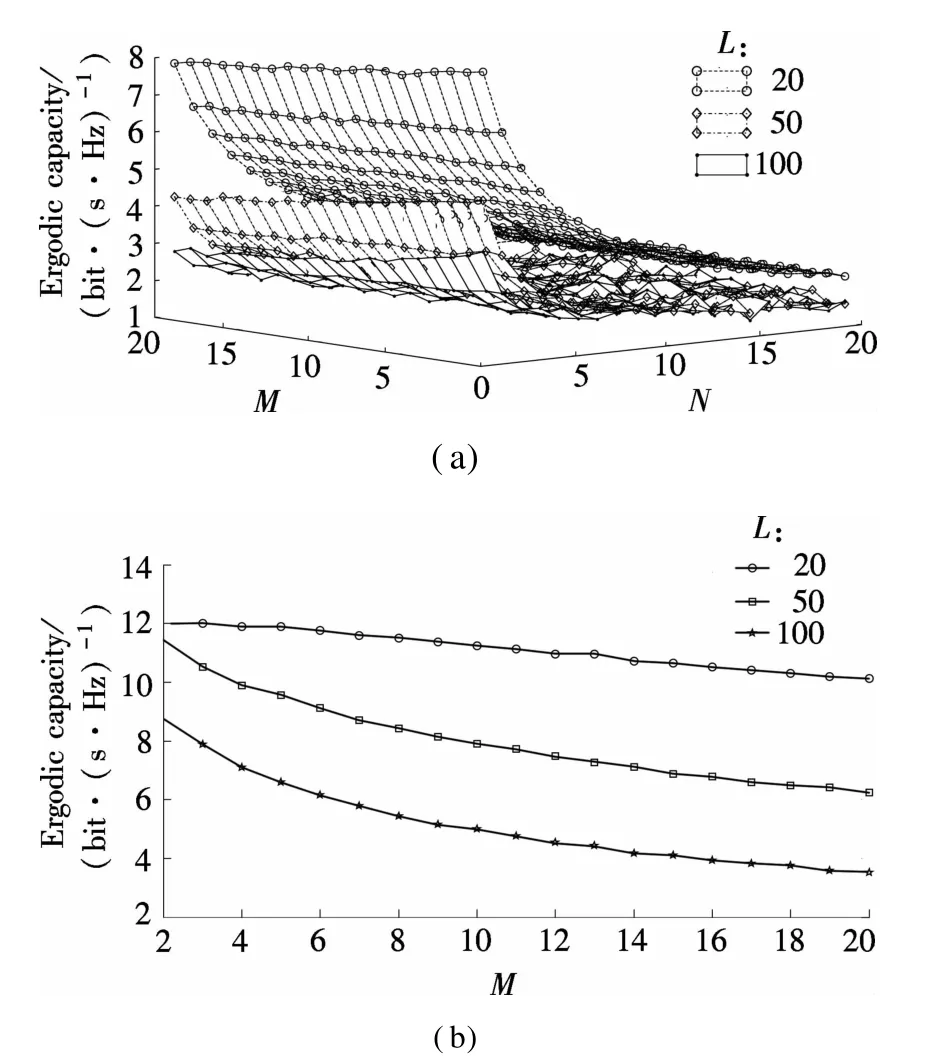
Fig.3 Average ergodic capacity of the DUE pair.(a)Uplink;(b)Downlink
4 Conclusion
In this paper,a D2D system model where M DUE pairs and N CUEs coexist is described.Then the CDF and PDF formulae of the SINR of the DUEs are presented.Based on the SINR formulae,the average ergodic capacity of the DUEs in D2D communications is analyzed and the corresponding formulae are derived.The simulation results show that DUEs can still obtain a high ergodic capacity even in the case of a large number of DUEs.This result can be applied to the design and optim ization of D2D communications.
[1]Doppler K,Rinne M,W ijting C,et al.Device-to-device communication as an underlay to LTE-advanced networks[J].IEEE Communications Magazine,2009,47(12):42-49.
[2]Yu C H,Doppler K,Ribeiro C B,etal.Resource sharing optimization for device-to-device communication underlaying cellular networks[J].IEEE Transactions on Wireless Communications,2011,10(8):2752- 2763.
[3]Min H,Seo W,Lee J,et al.Reliability improvement using receivemode selection in the device-to-device uplink period underlaying cellular networks[J].IEEE Transactions on Wireless Communications,2011,10(2):413- 418.
[4]Xu X,Sun J,Shao S.Transmission capacity of D2d communication under cellular networks[C]//International Conference on Computer Networks and Communication Engineering.Beijing,China,2013:375- 379.
[5]Liu Z,Peng T,Chen H,etal.Optimal D2D user allocation over multi-bands under heterogeneous networks[C]//IEEE Global Communications Conference.Anaheim,USA,2012:1339- 1344.
[6]M in H,Lee J,Park S,etal.Capacity enhancementusing an interference limited area for device-to-device uplink underlaying cellular networks[J].IEEE Transactions on Wireless Communications,2011,10(12):3995- 4000.
[7]Kaufman B,Lilleberg J,Aazhang B.Spectrum sharing scheme between cellular users and ad-hoc device-to-device users[J].IEEE Transactions on Wireless Communications,2013,12(3):1038- 1049.
[8]Golrezaei N,Molisch A F,Dimakis A G,et al.Fem tocaching and device-to-device collaboration:a new architecture for w ireless video distribution[J].IEEE Communications Magazine,2013,51(4):142- 149.
[9]Gupta P,Kumar P R.The capacity of w ireless networks[J].IEEE Transactions on Information Theory,2000,46(2):388- 404.
[10]Patel C S,Stuber G L,Pratt T G.Comparative analysis of statisticalmodels for the simulation of Rayleigh faded cellular channels[J].IEEE Transactions on Communications,2005,53(6):1017- 1026.
[11]Koutitas G,Karousos A,Tassiulas L.Deployment strategies and energy efficiency of cellular networks[J].IEEE Transactions on Wireless Communications,2012,11(7):2552- 2563.
[12]Goldsm ith A.Wireless communications[M].Cambridge:Cambridge University Press,2005:56- 58.
[13]Amari SV,Misra R B.Closed-form expressions for distribution of sum of exponential random variables[J].IEEE Transactions on Reliability,1997,46(4):519- 522.
[14]Rappaport T S.Wireless communications:principles and practice[M].Englewood,NJ,USA:Prentice Hall PTR,1996:102- 106.
蜂窝网络下D2D通信的遍历容量分析
李旭杰1,2,3张洪浪1张文娜1李文峰4
(1河海大学计算机与信息学院,南京210098)
(2复旦大学上海市智能信息处理重点实验室,上海200433)
(3中南民族大学智能无线通信湖北省重点实验室,武汉430074)
(4南京大学电子科学与工程学院,南京210023)
针对蜂窝网络下D2D通信系统提出了一种遍历容量分析方法.首先,对蜂窝网络下D2D通信模型进行了概述,并分析了其上行时隙和下行时隙的干扰情况.在D2D通信系统中很难得到瞬时的信道状态信息,故假设基站和终端仅知道统计的信道状态信息,且信道系数服从独立复高斯分布.基于上述假设,针对上行时隙得出DUE的信干噪比(SINR)表达式,并基于该公式推导出DUE的SINR的概率分布函数和概率密度函数,最终推导出DUE的上行遍历容量.利用相同方法,推导出下行遍历容量.仿真结果表明,即使存在较多DUE情况下仍然可以取得较高的遍历容量.研究结果可用于D2D通信系统的设计与优化.
D2D;遍历容量;蜂窝网
TN915
10.3969/j.issn.1003-7985.2015.03.006
signal powers at the BS,which are from all CUEs,are controlled at the same power level and denoted as.Then the
SINR at DUE k is given by
Received 2015-01-13.
Biography:Li Xujie(1979—),male,doctor,associate professor,lixujie@hhu.edu.cn.
s:The National Natural Science Foundation of China(No.61301110),Foundation of Shanghai Key Laboratory of Intelligent Information Processing of China(No.IIPL-2014-005).
:Li Xujie,Zhang Honglang,Zhang Wenna,et al.Ergodic capacity analysis for device-to-device communication underlaying cellular networks[J].Journal of Southeast University(English Edition),2015,31(3):333- 338.
10.3969/j.issn.1003-7985.2015.03.006
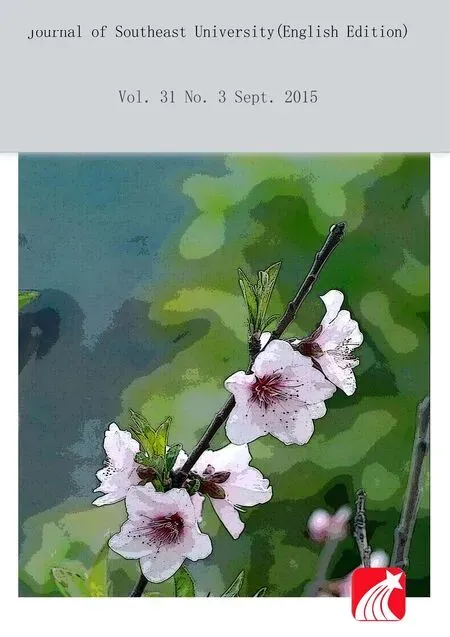 Journal of Southeast University(English Edition)2015年3期
Journal of Southeast University(English Edition)2015年3期
- Journal of Southeast University(English Edition)的其它文章
- Representations of the Drazin inverse involving idem potents in a ring
- Com p lexity and applicability analysis among OVM,GFM and FVDM models
- Relationship between number of passing events and operating parameters in m ixed bicycle traffic
- Influence analysis of chevron alignment signs on drivers’speed choices at horizontal curves on highways
- Extraction of cable forces due to dead load in cable-stayed bridges under random vehicle loads
- Finite elementmodeling of pavement responses based on stress-dependent properties of asphalt layer
